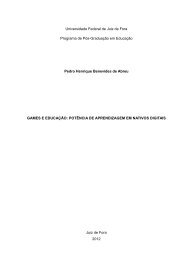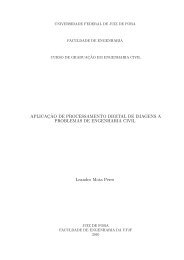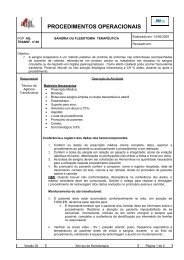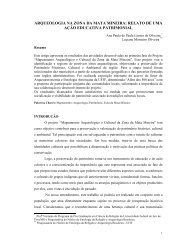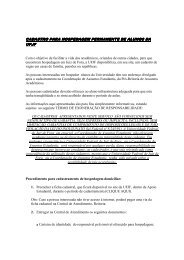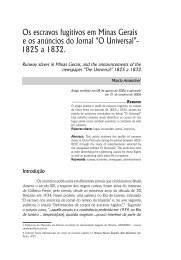Effects of Alkali the Atomization Furnace Atomic and Alkaline Earth ...
Effects of Alkali the Atomization Furnace Atomic and Alkaline Earth ...
Effects of Alkali the Atomization Furnace Atomic and Alkaline Earth ...
Create successful ePaper yourself
Turn your PDF publications into a flip-book with our unique Google optimized e-Paper software.
ANALYTICAL SCIENCES AUGUST 1990, VOL. 6 547<br />
<strong>Effects</strong><br />
<strong>of</strong> <strong>Alkali</strong><br />
<strong>the</strong> <strong>Atomization</strong><br />
<strong>Furnace</strong> <strong>Atomic</strong><br />
<strong>and</strong> <strong>Alkali</strong>ne <strong>Earth</strong> Metal<br />
<strong>of</strong> Lead <strong>and</strong> Chromium in<br />
Absorption Spectrometry<br />
Chlorides<br />
Graphite<br />
on<br />
S. BEKTAS* <strong>and</strong> S. AKMANt**<br />
*Hacettepe University , Department <strong>of</strong> Chemistry, 06532 Beytepe, Ankara, Turkey<br />
**Istanbul Technical University , Department <strong>of</strong> Chemistry, 80626 Maslak, Istanbul, Turkey<br />
Potassium chloride, calcium chloride, sodium chloride <strong>and</strong> magnesium chloride cause many different types <strong>of</strong><br />
interference in <strong>the</strong> determination <strong>of</strong> lead <strong>and</strong> chromium by graphite furnace atomic absorption spectrometry.<br />
Simultaneous volatilization <strong>of</strong> <strong>the</strong> analyte <strong>and</strong> <strong>the</strong> interferent from different, but close, points in <strong>the</strong> tube are very helpful<br />
in <strong>the</strong> explanation <strong>of</strong> interference mechanisms. The kind <strong>of</strong> interference that affects <strong>the</strong> sensitivity <strong>of</strong> <strong>the</strong> determination<br />
depends on <strong>the</strong> <strong>the</strong>rmal behavior <strong>of</strong> <strong>the</strong> matrix before <strong>and</strong> during atomization <strong>of</strong> <strong>the</strong> elements. If chloride vapor is<br />
formed by decomposition <strong>of</strong> <strong>the</strong> matrix before or during atomization <strong>of</strong> <strong>the</strong> analyte elements, <strong>the</strong> formation <strong>of</strong> a metal<br />
chloride in <strong>the</strong> gas phase may be responsible for decreasing in <strong>the</strong> sensitivity. If, on <strong>the</strong> o<strong>the</strong>r h<strong>and</strong>, <strong>the</strong> matrix is<br />
present as a solid or liquid while <strong>the</strong> elements atomize, <strong>the</strong> occlusion <strong>of</strong> <strong>the</strong> analyte in <strong>the</strong> bulk <strong>of</strong> <strong>the</strong> matrix <strong>and</strong> <strong>the</strong><br />
loss by a carrier-type mechanism or a slower transfer <strong>of</strong> heat to <strong>the</strong> analyte delaying <strong>the</strong> atomization cause some<br />
changes in <strong>the</strong> sensitivity. Expulsion <strong>of</strong> analyte vapors by exp<strong>and</strong>ing matrix gases was not effective due to <strong>the</strong> low<br />
heating-rate <strong>of</strong> <strong>the</strong> system used.<br />
Keywords Graphite furnace atomic absorption spectrometry, interferences, lead <strong>and</strong> chromium atomization<br />
Matrix interference in graphite furnace atomic absorption<br />
spectrometry has been widely studied since this<br />
method became popular in <strong>the</strong> early 1970s <strong>and</strong> <strong>the</strong><br />
literature is full <strong>of</strong> reports on problems <strong>of</strong> different<br />
origin.<br />
Reports were made on <strong>the</strong> volatility <strong>of</strong> a chromium<br />
compound that led to substantial losses during <strong>the</strong>rmal<br />
pretreatment in a furnace.' Never<strong>the</strong>less, o<strong>the</strong>r authors<br />
were unable to find volatile chromium compounds.2<br />
There are reports in <strong>the</strong> literature on relatively strong<br />
interference due to chloride3'4, as well, which could not<br />
be verified by o<strong>the</strong>r authors.5 Frech et al.6 stated that a<br />
<strong>the</strong>rmal pretreatment stage in a graphite tube must be<br />
considered as a potential source for chromium losses<br />
(particularly when chlorine is present), since gaseous<br />
chromium oxychloride, CrO2C12(g), may be formed.<br />
They stated that since gaseous chromium oxychloride<br />
was stable at temperatures up to 1200° C <strong>the</strong>re is a risk<br />
for losses <strong>of</strong> chromium at intermediate temperatures.<br />
CrC12(s), on <strong>the</strong> o<strong>the</strong>r h<strong>and</strong>, was present on <strong>the</strong> tube<br />
surface between 1300 -1700° C. Chromium is known to<br />
form stable metallic carbides', <strong>and</strong> this has been<br />
reported to be <strong>the</strong> reason for <strong>the</strong> incomplete volatilization<br />
<strong>of</strong> chromium from graphite tubes.8 The formation<br />
<strong>of</strong> <strong>the</strong> chromium carbide has been mentioned by many<br />
t To whom correspondence should be addressed.<br />
workers.6'9' 10<br />
Lead is a very popular element in graphite furnace<br />
atomic absorption spectrometry. Many publications on<br />
<strong>the</strong> determination <strong>of</strong> lead in various samples reported<br />
numerous types <strong>of</strong> interference. Ottaway" reported a<br />
considerable signal depression due to chlorides <strong>and</strong><br />
observed <strong>the</strong> spectrum <strong>of</strong> lead chloride. He concluded<br />
that lead is volatilized in molecular form. Czobik <strong>and</strong><br />
Matousek12 referred to <strong>the</strong> carrier effect that leads to<br />
simultaneous volatilization <strong>of</strong>, for example, sodium<br />
chloride <strong>and</strong> lead; sodium chloride can volatilize in<br />
microgram quantities at temperature slightly above<br />
700° C <strong>and</strong> can carry lead with it. These authors<br />
established that in <strong>the</strong> presence <strong>of</strong> sodium chloride <strong>the</strong><br />
lead signal virtually coincides with <strong>the</strong> volatilization <strong>of</strong><br />
sodium chloride from <strong>the</strong> tube wall. Yasuda <strong>and</strong><br />
Kakiyama'3"4 assumed that elements such as cadmium,<br />
lead <strong>and</strong> zinc form gaseous metal chlorides in <strong>the</strong><br />
presence <strong>of</strong> higher chloride concentrations <strong>and</strong> that<br />
<strong>the</strong>se are partially transported from <strong>the</strong> tube at <strong>the</strong> start<br />
<strong>of</strong> atomization. They observed <strong>the</strong> spectra <strong>of</strong> numerous<br />
metal halides at relatively low temperatures which,<br />
however, did not appear at higher temperatures.<br />
Smeyers-Verbeke et al.'s found that alkaline-earthchlorides<br />
can lead to losses <strong>of</strong> <strong>the</strong> analyte element<br />
during a <strong>the</strong>rmal pretreatment. They reported that<br />
through a careful choice <strong>of</strong> <strong>the</strong> <strong>the</strong>rmal pretreatment
548<br />
ANALYTICAL SCIENCES AUGUST 1990, VOL. 6<br />
program, <strong>the</strong> interferent could be removed <strong>and</strong> <strong>the</strong><br />
interference thus reduced or eliminated. Fuller16 found<br />
substantial differences for <strong>the</strong> interference <strong>of</strong> magnesium<br />
chloride on <strong>the</strong> determination <strong>of</strong> lead depending<br />
on <strong>the</strong> graphite surface. While strong interference<br />
could be observed in new uncoated tubes <strong>and</strong> in<br />
pyrocoated tubes, no interference was observed in aged<br />
tubes. The interference due to magnesium chloride<br />
could be eliminated by <strong>the</strong> addition <strong>of</strong> oxalic acid.<br />
Both oxalic acid <strong>and</strong> finely dispersed carbon in aged<br />
tubes reduce lead oxide to metallic lead. Fuller thus<br />
concluded that <strong>the</strong> interference due to magnesium<br />
chloride is a vapor-phase interference. Many authors17-'9<br />
suggested that <strong>the</strong> graphite surface played an<br />
important role <strong>and</strong> affected <strong>the</strong> atomization <strong>and</strong><br />
interference mechanisms for lead. These mechanisms<br />
may be affected by <strong>the</strong> presence <strong>of</strong> reagents such as<br />
nitrates <strong>and</strong> by <strong>the</strong> oxygen released from <strong>the</strong> nitrate<br />
decomposition.l9-21 Frech <strong>and</strong> Cedergren22 were able to<br />
show for <strong>the</strong> determination <strong>of</strong> lead in steel that in <strong>the</strong><br />
absence <strong>of</strong> hydrogen, volatile lead chlorides are formed<br />
at 400° C, leading to losses during <strong>the</strong>rmal pretreatment.<br />
In <strong>the</strong> presence <strong>of</strong> sufficiently large quantity <strong>of</strong><br />
hydrogen, chlorine is expelled from <strong>the</strong> graphite tube at<br />
600° C as hydrogen chloride. If, on <strong>the</strong> o<strong>the</strong>r h<strong>and</strong>, <strong>the</strong><br />
sample is present in a nitric acid solution <strong>and</strong> a<br />
relatively high <strong>the</strong>rmal pretreatment temperature is not<br />
applied, <strong>the</strong> partial pressure <strong>of</strong> oxygen during atomization<br />
can be quite large. Gaseous lead oxides can <strong>the</strong>n<br />
be formed, leading to a loss in sensitivity.23 One <strong>of</strong> <strong>the</strong><br />
main causes for vapor-phase interferences in graphite<br />
furnaces is <strong>the</strong> formation <strong>of</strong> monohalides. A shift <strong>of</strong><br />
<strong>the</strong> dissociation equilibrium through decomposition<br />
products <strong>of</strong> <strong>the</strong> solvent or <strong>the</strong> matrix, is a fur<strong>the</strong>r<br />
important factor. Even small quantities <strong>of</strong> gaseous<br />
chlorine cause a redistribution <strong>of</strong> lead in <strong>the</strong> gas phase<br />
so that it is present as <strong>the</strong> volatile monochloride PbCI<br />
<strong>and</strong> dichloride PbC12.22 These forms are mostly<br />
expelled with <strong>the</strong> purge gas, so that substantial losses <strong>of</strong><br />
lead occur. In <strong>the</strong> presence <strong>of</strong> hydrogen, on <strong>the</strong> o<strong>the</strong>r<br />
h<strong>and</strong>, high chloride concentrations can be tolerated<br />
before noticeable quantities <strong>of</strong> lead chlorides are<br />
formed. According to Frech <strong>and</strong> Cedergren23, in an<br />
iso<strong>the</strong>rmal furnace, interference should hardly occur for<br />
<strong>the</strong> determination <strong>of</strong> lead in <strong>the</strong> presence <strong>of</strong> higher concentrations<br />
<strong>of</strong> sodium chloride. Sodium chloride is a<br />
relatively stable molecule <strong>and</strong> <strong>the</strong> partial pressure <strong>of</strong><br />
chlorine is low. Pb(g) is <strong>the</strong> preferred species above<br />
1200° C <strong>and</strong> PbC12(g) only occurs in larger quantities<br />
below 900° C. Never<strong>the</strong>less, it should be emphasized<br />
that <strong>the</strong>se conditions are valid only for an iso<strong>the</strong>rmal<br />
furnace. Slavin <strong>and</strong> coworkers24,25 have pointed out<br />
that at least some <strong>of</strong> <strong>the</strong> previously described matrix<br />
interference due to chlorides actually losses represented<br />
<strong>of</strong> <strong>the</strong> analyte element in <strong>the</strong> form <strong>of</strong> <strong>the</strong> volatile<br />
chlorides during <strong>the</strong>rmal pretreatment. Never<strong>the</strong>less,<br />
<strong>the</strong>y could not rule out vapor-phase interferences, since<br />
<strong>the</strong> bond energies <strong>of</strong> gaseous metal halides are very<br />
large <strong>and</strong> complete dissociation may not occur. This<br />
was confirmed by Siemer et al.26 who showed that <strong>the</strong><br />
signal suppression for lead in <strong>the</strong> presence <strong>of</strong> iron<br />
chloride could be reduced when <strong>the</strong> analyte vapor was<br />
observed in a zone <strong>of</strong> higher temperature. Welz et al.27,<br />
who tested <strong>the</strong> integrated response for lead in nickel<br />
chloride <strong>and</strong> sodium chloride using "dual-cavity platform",<br />
found that in spite <strong>of</strong> <strong>the</strong> substantially different physical<br />
<strong>and</strong> chemical properties <strong>of</strong> <strong>the</strong> two chlorides, <strong>the</strong> interference<br />
appeared, in general, to proceed by <strong>the</strong> same<br />
mechanisms. No evidence could be found for a gasphase<br />
reaction interference. Lead chloride was formed<br />
in <strong>the</strong> condensed phase <strong>and</strong> lost in <strong>the</strong> form <strong>of</strong> gaseous<br />
molecules during <strong>the</strong>rmal pretreatment or early in <strong>the</strong><br />
atomization stage. Expulsion <strong>of</strong> <strong>the</strong> analyte from <strong>the</strong><br />
furnace toge<strong>the</strong>r with <strong>the</strong> very rapidly exp<strong>and</strong>ing gases<br />
due to <strong>the</strong> fast heating rate applied during <strong>the</strong> atomization<br />
stage was a very important<br />
type interference.<br />
In our previous paper28 <strong>the</strong> effects <strong>of</strong> sodium<br />
chloride, calcium chloride <strong>and</strong> magnesium chloride on<br />
<strong>the</strong> atomization behavior <strong>of</strong> manganese <strong>and</strong> cadmium<br />
were examined <strong>and</strong> volatilization <strong>of</strong> <strong>the</strong> analyte element<br />
<strong>and</strong> <strong>the</strong> interferent from separate points <strong>of</strong> <strong>the</strong> graphite<br />
tube has been proved useful in providing more<br />
information on <strong>the</strong> interference mechanisms. It was<br />
pointed out that if a near-coincidence in appearance<br />
times <strong>of</strong> analyte <strong>and</strong> matrix atoms existed, gas-phase<br />
interference can be expected. If, on <strong>the</strong> o<strong>the</strong>r h<strong>and</strong>, <strong>the</strong><br />
matrix was still in <strong>the</strong> condensed phase during<br />
atomization <strong>of</strong> <strong>the</strong> analyte, occlusion <strong>of</strong> <strong>the</strong> element in<br />
<strong>the</strong> matrix <strong>and</strong> loss by carrier mechanism was quite<br />
possible.<br />
In this work, <strong>the</strong> effects <strong>of</strong> potassiumm chloride,<br />
calcium chloride, sodium chloride <strong>and</strong> magnesium<br />
chloride on <strong>the</strong> atomization behavior <strong>of</strong> lead <strong>and</strong><br />
chromium were examined by <strong>the</strong> interpretation <strong>of</strong> <strong>the</strong><br />
<strong>the</strong>rmal pretreatment temperature curves obtained for<br />
"<strong>the</strong> analyte alone"<br />
, "<strong>the</strong> analyte in <strong>the</strong> matrix" <strong>and</strong>"<strong>the</strong><br />
matrix alone" toge<strong>the</strong>r with <strong>the</strong>ir physical <strong>and</strong> chemical<br />
properties. In addition, <strong>the</strong> pipetting <strong>of</strong> <strong>the</strong> analyte <strong>and</strong><br />
<strong>the</strong> matrix separately onto <strong>the</strong> different, but close,<br />
points <strong>of</strong> <strong>the</strong> tube helped to explain <strong>of</strong> <strong>the</strong> effects <strong>of</strong><br />
<strong>the</strong> matrix on <strong>the</strong> atomization <strong>of</strong> <strong>the</strong> analyte.<br />
Experimental<br />
A Perkin-Elmer Model 400 atomic absorption spectrometer<br />
equipped with a HGA-74 graphite furnace <strong>and</strong> a<br />
continuum source background corrector was used<br />
throughout this work. The absorbances were read as<br />
peak height from a Perkin-Elmer Model 56 recorder.<br />
Lead determinations were carried out with a hollow<br />
cathode lamp operated at 8 mA at <strong>the</strong> 283.3-nm line<br />
<strong>and</strong> a spectral b<strong>and</strong> width <strong>of</strong> 0.7 nm. Chromium,<br />
determinations were carried out with a hollow cathode<br />
lamp operated at 10 mA at <strong>the</strong> 357.8 nm <strong>and</strong> a spectral<br />
b<strong>and</strong> width <strong>of</strong> 0.2 nm. The 1000 ppm stock solutions <strong>of</strong><br />
<strong>the</strong> elements <strong>of</strong> interest were prepared by dissolving<br />
Pb(N03)2 in lord HNO3 <strong>and</strong> Cr metal rod in minimum
ANALYTICAL SCIENCES AUGUST 1990, VOL. 6<br />
volume <strong>of</strong> concentrated HCl <strong>and</strong> were diluted to<br />
volume. Stock matrix solutions (10%w/ v) were<br />
prepared from NaCI, KCI, CaC12.2H2O <strong>and</strong> MgC12<br />
6H2O salts. All <strong>of</strong> <strong>the</strong> chemicals were <strong>of</strong> analytical<br />
reagent grade <strong>and</strong> were not fur<strong>the</strong>r purified. Test<br />
solutions were diluted daily to appropriate concentrations<br />
with freshly distilled deionized water. Aliquots <strong>of</strong><br />
20 µl <strong>of</strong> 0.5 ppm lead reference solution (1X108 .g), <strong>and</strong><br />
0.06 ppm chromium reference solution (1.2X 10-9 g)<br />
were used throughout <strong>the</strong> work. Twenty microliters <strong>of</strong><br />
1 %w/ v potassium, calcium <strong>and</strong> sodium chlorides (2X<br />
10.4 g) <strong>and</strong> 20 tl <strong>of</strong> 6%w/ v <strong>of</strong> magnesium chloride (1.2X<br />
10-3 g) were used unless o<strong>the</strong>rwise stated. All solutions<br />
were introduced with a Finn pipet <strong>and</strong> <strong>the</strong> injection<br />
hole was enlarged to facilitate sample pipetting onto <strong>the</strong><br />
separate points <strong>of</strong> graphite tube. Drops <strong>of</strong> solutions<br />
onto <strong>the</strong> surface were controlled by using a mirror to be<br />
sure not to mix with each o<strong>the</strong>r. In <strong>the</strong> case <strong>of</strong> mixing<br />
during <strong>the</strong> drying step, <strong>the</strong> program was stopped, <strong>the</strong><br />
tube was cleaned by applying maximum heating <strong>and</strong><br />
<strong>the</strong> procedure was repeated. The operating parameters<br />
<strong>of</strong> graphite furnace are given in Table 1.<br />
The change <strong>of</strong> temperature with time in <strong>the</strong> atomization<br />
step was calibrated with an optical pyrometer.<br />
Nitrogen was used as purge gas <strong>and</strong> <strong>the</strong> graphite tubes<br />
were uncoated. All data points given in this work are<br />
averages <strong>of</strong> several repetitions on different days using<br />
different tubes. A background corrector was always<br />
operated during all determinations.<br />
Table 1 Operating parameters for HGA-74 furnace<br />
Results <strong>and</strong> Discussion<br />
Non-spectral matrix interference could be due to<br />
several different processes:27 (i) a condensed-phase<br />
reaction between <strong>the</strong> analyte <strong>and</strong> matrix <strong>and</strong> <strong>the</strong><br />
formation <strong>of</strong> a compound which is volatilized <strong>and</strong><br />
carried out <strong>of</strong> <strong>the</strong> absorption volume without being<br />
atomized; (ii) a gas-phase interference, i.e. a reaction<br />
between analyte atoms <strong>and</strong> matrix atoms or radicals to<br />
form gaseous molecules <strong>of</strong> different <strong>the</strong>rmostability;<br />
(iii) occlusion <strong>of</strong> <strong>the</strong> analyte in <strong>the</strong> bulk <strong>of</strong> <strong>the</strong> matrix<br />
<strong>and</strong> loss by a carrier mechanism; (iv) expulsion <strong>of</strong> <strong>the</strong><br />
analyte vapor toge<strong>the</strong>r with rapidly exp<strong>and</strong>ing matrix<br />
gases.<br />
Table 2 shows <strong>the</strong> absorbance values obtained from<br />
separated <strong>and</strong> mixed pipetting <strong>of</strong> <strong>the</strong> analyte <strong>and</strong><br />
interferent toge<strong>the</strong>r with <strong>the</strong> analyte alone. Separate<br />
volatilization <strong>of</strong> <strong>the</strong> analyte <strong>and</strong> interferent from<br />
different, but close, spots in <strong>the</strong> graphite tube has been<br />
very informative for a better underst<strong>and</strong>ing <strong>of</strong> interference<br />
mechanisms. This arrangement allows independent<br />
volatilization <strong>of</strong> <strong>the</strong> analyte element <strong>and</strong> <strong>the</strong><br />
interferent which do not come into contact in <strong>the</strong><br />
condensed phase. It can be expected that volatilized<br />
species mix readily in <strong>the</strong> gas-phase so that interference<br />
due to gas-phase interactions (i.e. mechanisms (ii) <strong>and</strong><br />
(iv)) remain essentially <strong>the</strong> same when <strong>the</strong> analyte <strong>and</strong><br />
interferent are mixed or separated. Condensed phase<br />
interactions (i.e. mechanisms (i) <strong>and</strong> (iii)) must disappear<br />
when <strong>the</strong> analyte <strong>and</strong> interferent meet only in <strong>the</strong> gasphase,<br />
though. Consequently, in <strong>the</strong> case <strong>of</strong> mechanisms<br />
(i) <strong>and</strong> (iii), which require intimate contact between<br />
analyte <strong>and</strong> interferent in <strong>the</strong> condensed phase, different<br />
sensitivities should be obtained for mixed <strong>and</strong> separated<br />
pipetting <strong>of</strong> <strong>the</strong> analyte <strong>and</strong> interferent. If, on <strong>the</strong> o<strong>the</strong>r<br />
h<strong>and</strong>, <strong>the</strong> same sensitivity loss is obtained for both<br />
mixed <strong>and</strong> separated solutions, which means <strong>the</strong><br />
interference is independent whe<strong>the</strong>r <strong>the</strong> analyte <strong>and</strong><br />
interferent are mixed or not, <strong>the</strong>n only alternatives (ii)<br />
<strong>and</strong> (iv) should be taken into account. If (1)=(3)±(2) in<br />
Table 2 <strong>Effects</strong> <strong>of</strong> separate volatilization <strong>of</strong> <strong>the</strong> analyte element <strong>and</strong> interferent from different but close points in <strong>the</strong> tube center<br />
a. The average <strong>of</strong> many repetitive absorbance values was accepted 1.00 for <strong>the</strong> sake <strong>of</strong> simplicity <strong>and</strong> <strong>the</strong> average <strong>of</strong> absorbances<br />
obtained from o<strong>the</strong>r experiments, (2) <strong>and</strong> (3), were relative values with respect to <strong>the</strong> average <strong>of</strong> analyte alone. All <strong>the</strong> experimental<br />
conditions are as given in <strong>the</strong> experimental section. Thermal pretreatment temperature is 300° C.
550<br />
Table 2, alternatives (i) <strong>and</strong> (iii) come into consideration,<br />
e.g. Pb in KCI, CaCl2 <strong>and</strong> MgCl2, <strong>and</strong> Cr in<br />
MgCl2. If (2)=(3)±(1) <strong>the</strong>n (ii) as well as (iv) can be<br />
predicted, e.g. Cr in KCI, CaCl2 <strong>and</strong> NaCI. If (1)=(2)±(3)<br />
<strong>the</strong>n all <strong>the</strong> alternatives should be considered, e.g. Pb in<br />
NaCI. A clear distinction between possible interference<br />
mechanisms is frequently difficult <strong>and</strong> sometimes impossible.<br />
The predictions should be supported by<br />
fur<strong>the</strong>r experiments. More detailed information could<br />
be obtained from <strong>the</strong> interpretation <strong>of</strong> <strong>the</strong> <strong>the</strong>rmal pretreatment<br />
graphs given below.<br />
<strong>Effects</strong> <strong>of</strong> potassium chloride<br />
The influence <strong>of</strong> <strong>the</strong> <strong>the</strong>rmal pretreatment temperature<br />
on <strong>the</strong> atomization signal for lead alone in <strong>the</strong> presence<br />
<strong>of</strong> a 20000-fold excess <strong>of</strong> potassium chloride <strong>and</strong> nonspecific<br />
absorbance from potassium chloride at <strong>the</strong> lead<br />
wavelength are depicted in Fig. 1(a). Essentially, <strong>the</strong><br />
behavior <strong>of</strong> molecular absorption vs. temperature<br />
curves does not change with wavelength in all figures;<br />
we only used <strong>the</strong> ones obtained at <strong>the</strong> lead wavelength.<br />
An examination <strong>of</strong> <strong>the</strong> plots reveals that lead signals<br />
are a little affected by <strong>the</strong> matrix. The loss <strong>of</strong><br />
potassium chloride begins at about 500° C; it almost<br />
completely leaves <strong>the</strong> furnace at 900° C for a pretreatment<br />
time <strong>of</strong> 20 s. The atomization temperature <strong>of</strong><br />
potassium taken as its chloride was found to be about<br />
1300°C.29 Accordingly, <strong>the</strong> reason for <strong>the</strong> loss <strong>of</strong><br />
potassium chloride at lower temperatures should be <strong>the</strong><br />
removal <strong>of</strong> <strong>the</strong> salt as molecular vapor, ra<strong>the</strong>r than<br />
<strong>the</strong>rmal decomposition to its atoms. The appearance <strong>of</strong><br />
potassium <strong>and</strong> chlorine atoms in <strong>the</strong> gas phase is<br />
possible only after 1300°C, whereas <strong>the</strong> atomization<br />
temperature <strong>of</strong> lead in <strong>the</strong> matrix is 800° C; even when<br />
<strong>the</strong> peak maximum <strong>of</strong> lead is reached, <strong>the</strong>re are still no<br />
free chlorine atoms present in <strong>the</strong> gas phase. One can,<br />
<strong>the</strong>refore, not expect that <strong>the</strong> lead <strong>and</strong> chlorine atoms<br />
will combine in <strong>the</strong> gas phase to depress <strong>the</strong> lead atomic<br />
absorption signal. Table 2 is consistent with this<br />
proposal. The formation <strong>of</strong> lead chloride in <strong>the</strong><br />
condensed phase during <strong>the</strong> pretreatment step, which is<br />
ANALYTICAL SCIENCES AUGUST 1990, VOL. 6<br />
volatilized <strong>and</strong> carried out <strong>of</strong> absorption volume, seems<br />
to be unlikely because removal <strong>of</strong> lead as volatile lead<br />
chloride during pretreatment step should have been<br />
increased proportionally with <strong>the</strong> pretreatment temperature<br />
as well as time. In an additional set <strong>of</strong><br />
experiments, it was observed that <strong>the</strong> duration <strong>of</strong> <strong>the</strong><br />
pretreatment step did not affect <strong>the</strong> "lead in potassium<br />
chloride" signal. Both "lead alone" <strong>and</strong> "lead in<br />
potassium chloride" curves are stable up to 800° C <strong>and</strong> in<br />
fact a little increase was observed for lead mixed with<br />
potassium chloride after 600° C. This shows that <strong>the</strong>re<br />
is no lead loss during <strong>the</strong> pretreatment step in <strong>the</strong><br />
presence <strong>of</strong> potassium chloride; thus a condensed phase<br />
reaction can be excluded. Lead may be occluded as its<br />
molecular or atomic form <strong>and</strong> carried in potassium<br />
chloride clusters during <strong>the</strong> atomization step i.e.<br />
mechanism (iii). Figure 1 supports this idea because<br />
occlusion should be independent <strong>of</strong> <strong>the</strong> <strong>the</strong>rmal pretreatment<br />
temperature as long as <strong>the</strong> matrix does not<br />
vaporize <strong>and</strong> (as shown in <strong>the</strong> figure), "lead in<br />
potassium chloride" curve does not change below<br />
600° C. An increase in <strong>the</strong> <strong>the</strong>rmal pretreatment curve<br />
for "lead mixed with potassium chloride" between 600 -<br />
800° C is due to <strong>the</strong> removal <strong>of</strong> some potassium<br />
chloride during <strong>the</strong> pretreatment step; a smaller amount<br />
<strong>of</strong> interferent is left in <strong>the</strong> tube to carry lead atoms in<br />
<strong>the</strong> atomization step. The data given in Table 2 is in<br />
good agreement with this proposal. Alternative (iv), i.e.<br />
expulsion <strong>of</strong> <strong>the</strong> analyte vapor toge<strong>the</strong>r with rapidly<br />
exp<strong>and</strong>ing matrix gases which was proposed by many<br />
workers27'30 seems to be ineffective, or negligible in our<br />
conditions because if it had occured, absorption due to<br />
separate pipetting <strong>of</strong> <strong>the</strong> analyte <strong>and</strong> matrix would have<br />
been affected to a some degree when compared with<br />
lead alone; but, it did not. The reason for this<br />
discrepancy is quite clear. The HGA-74 graphite<br />
furnace used in this work has a low heating rate which<br />
decreases <strong>the</strong> analyte vapor expulsion from <strong>the</strong> furnace<br />
toge<strong>the</strong>r with rapidly exp<strong>and</strong>ing matrix gases. On <strong>the</strong><br />
othre h<strong>and</strong>, this mechanism is very effective due to <strong>the</strong><br />
very fast heating rates used in those systems.<br />
Fig. 1 Thermal pretreatment temperature graphs for (a) lead, (b) chromium: A, analyte<br />
alone (lead 10 ng, chromium 1.2 ng); B, analyte mixed with 0.2 mg KC1; C, 0.2 mg KCl<br />
background absorbance.
ANALYTICAL SCIENCES AUGUST 1990, VOL. 6<br />
For <strong>the</strong> effects <strong>of</strong> potasssium chloride on chromium,<br />
<strong>the</strong> curves in Fig. 1(b) can be easily explained in terms <strong>of</strong><br />
<strong>the</strong> <strong>the</strong>rmal properties <strong>of</strong> chromium <strong>and</strong> potassium<br />
chloride. As explained before, potassium chloride<br />
atomizes at 1300°C although it vaporizes at lower<br />
temperatures as <strong>the</strong> molecular form. The atomization<br />
temperature <strong>of</strong> chromium in potassium chloride was<br />
found to be 1350° C. Consequently, a near coincidence<br />
in <strong>the</strong> appearance times <strong>of</strong> chromium <strong>and</strong> chlorine atoms<br />
makes a gas-phase reaction possible to form a molecule,<br />
i.e. mechanism(ii). Table 2 strongly supports this<br />
mechanism. The atomic absorptipn potassium signal<br />
taken with a potassium hollow cathode lamp for 2X104<br />
g KCl under <strong>the</strong> conditions used for lead or chromium<br />
atomization actually remains at a high level over an<br />
exp<strong>and</strong>ed period <strong>of</strong> time, which suggests a flow <strong>of</strong><br />
potassium or chlorine atoms causing <strong>the</strong> expulsion <strong>of</strong><br />
analyte vapor from <strong>the</strong> tube as well as formation <strong>of</strong> a<br />
molecule in <strong>the</strong> gas-phase. Analyte vapor expulsion<br />
from <strong>the</strong> furnace toge<strong>the</strong>r with vaporization matrix<br />
(alternative (iv)) should be considered whenever a gasphase<br />
reaction is proposed especially when a near<br />
coincidence in appearance times <strong>of</strong> analyte <strong>and</strong> matrix<br />
exists. Table 2 <strong>and</strong> Fig. 1(b) are not in disagreement<br />
with this mechanism. Table 2, on <strong>the</strong> o<strong>the</strong>r h<strong>and</strong>,<br />
makes condensed-phase interference impossible, so <strong>the</strong><br />
condensed-phase reaction between <strong>the</strong> analyte element<br />
<strong>and</strong> <strong>the</strong> interferent to form a volatile compound during<br />
<strong>the</strong>rmal pretreatment step or occlusion <strong>of</strong> analyte in <strong>the</strong><br />
matrix, i.e, mechanisms (i) <strong>and</strong> (iii) can be eliminated.<br />
When <strong>the</strong> <strong>the</strong>rmal pretreatment temperature is adjusted<br />
to a value higher than 600° C, potassium chloride,<br />
which causes interference in <strong>the</strong> atomization step, is<br />
partly removed from <strong>the</strong> furnace <strong>and</strong> <strong>the</strong> chromium<br />
signals are partly restored; finally, at <strong>the</strong>rmal pretreatment<br />
temperatures above 1100°C, reach to "chromium<br />
alone" value because <strong>the</strong>re is no potassium<br />
chloride left in <strong>the</strong> tube to cause any interference during<br />
atomization. It is important to note that although <strong>the</strong><br />
shapes <strong>of</strong> <strong>the</strong> curves in Figs. 1(a) <strong>and</strong> (b) are alike, <strong>the</strong>ir<br />
causes are completely different. We have discussed all<br />
<strong>of</strong> <strong>the</strong> alternatives for potassium chloride in detail; from<br />
now on, <strong>the</strong> possible alternatives for o<strong>the</strong>r interferents<br />
will be more briefly discussed, unless a situation not<br />
mentioned<br />
occurs.<br />
<strong>Effects</strong> <strong>of</strong> calcium chloride<br />
Figure 2(a) shows <strong>the</strong> effect <strong>of</strong> calcium chloride on<br />
lead absorbance. The <strong>the</strong>rmal behavior <strong>of</strong> calcium<br />
chloride is similar to that <strong>of</strong> potassium chloride. The<br />
atomization temperature <strong>of</strong> calcium, taken as chloride,<br />
was found to be 1550° C.29 However, <strong>the</strong> calcium<br />
chloride <strong>the</strong>rmal pretreatment curve starts decreasing at<br />
about 800°C, far below <strong>the</strong> atomization temperature.<br />
These losses should be due to <strong>the</strong> vaporization <strong>of</strong><br />
calcium chloride in a <strong>the</strong>rmal pretreatment step, like<br />
potassium chloride. The hydrolysis <strong>of</strong> calcium chloride<br />
can form calcium oxide, CaO, which may be responsible<br />
from <strong>the</strong> decrease in <strong>the</strong> calcium chlorides signal;<br />
however, <strong>the</strong> transfer <strong>of</strong> CaO to <strong>the</strong> vapor phase can<br />
not be expected because CaO is known to be an<br />
involatile substance (tbp=2850° C).3' The geseous<br />
chlorine atoms from calcium chloride can only be<br />
present above 1550°C, a temperature too high even for<br />
<strong>the</strong> peak maximum <strong>of</strong> "lead mixed with calcium<br />
chloride" absorption signal. In this situation no gasphase<br />
reaction, i.e. alternative (ii), can be expected.<br />
Table 2 strongly supports <strong>the</strong> absence <strong>of</strong> a gas-phase<br />
reaction. From <strong>the</strong> data in Table 2, only a condensedphase<br />
effect can be expected. Therefore, <strong>the</strong> expulsion<br />
<strong>of</strong> lead atoms with a rapidly exp<strong>and</strong>ing matrix,<br />
alternative (iv), can be easily eliminated as well. If it<br />
were possible, separate injection would be affected from<br />
this interference.27,30 From <strong>the</strong> curves in Fig. 2(a), <strong>the</strong><br />
formation <strong>of</strong> volatile lead chloride in a condensed<br />
phase, alternative (i), seems to be unlikely because<br />
signal depression is independent <strong>of</strong> <strong>the</strong> pretreatment<br />
temperature before <strong>the</strong> vaporization <strong>of</strong> calcium chloride;<br />
moreover, in an additional set <strong>of</strong> experiments <strong>the</strong><br />
duration <strong>of</strong> <strong>the</strong> pretreatment step did not affect <strong>the</strong><br />
signal. In this situation, <strong>the</strong> most possible mechanism<br />
seems to be occlusion.<br />
551<br />
Fig. 2 Thermal pretreatment temperature graphs for (a) lead, (b) chromium: A, analyte<br />
alone (lead 10 ng, chromium 1.2 ng); B, analyte mixed with 0.2 mg CaC12; C, 0.2 mg<br />
CaC12 background absorbance.
552 ANALYTICAL SCIENCES AUGUST 1990, VOL. b<br />
An examination <strong>of</strong> <strong>the</strong> curves in Fig. 2(b), which are<br />
quite similar to that <strong>of</strong> "chromium in ptassium<br />
chloride" (Fig. 1(b)), again indicates a depressive effect<br />
<strong>of</strong> calcium chloride on <strong>the</strong> chromium absorbance.<br />
From <strong>the</strong> previous discussion, we have known that free<br />
gaseous chlorine atoms will be formed after 1550°C, a<br />
temperature which is quite close to <strong>the</strong> atomization<br />
temperature <strong>of</strong> chromium. Threfore, if <strong>the</strong> <strong>the</strong>rmal<br />
pretreatment temperature is adjusted to below 800° C,<br />
<strong>the</strong>n during <strong>the</strong> atomization step, starting from about<br />
800° C, <strong>the</strong> matrix will evaporate rapidly <strong>and</strong> a small<br />
amount <strong>of</strong> residue (may be not at all) will be left on <strong>the</strong><br />
graphite surface while chromium atomizes. Because <strong>of</strong><br />
<strong>the</strong> simultaneous existence <strong>of</strong> chromium <strong>and</strong> chlorine<br />
atoms in <strong>the</strong> vapor phase, <strong>the</strong> resulting gas-phase reaction<br />
to form a molecule is most probable. After a<br />
pre-atomization temperature <strong>of</strong> 1400° C, <strong>the</strong> interfering<br />
matrix leaves <strong>the</strong> furnace, restoring <strong>the</strong> signal to its<br />
original value. The data in Table 2 are in good<br />
agreement with a gas-phase reaction. Never<strong>the</strong>less, <strong>the</strong><br />
probability <strong>of</strong> expulsion <strong>of</strong> <strong>the</strong> analyte from <strong>the</strong> furnace<br />
toge<strong>the</strong>r with exp<strong>and</strong>ing matrix gases (or its decomposition<br />
products) should also be taken into consideration.<br />
The atomic absorption signal <strong>of</strong> calcium obtained from<br />
<strong>the</strong> atomization <strong>of</strong> 2X104 g <strong>of</strong> calcium chloride actually<br />
remains at a high level over an extended period <strong>of</strong> time,<br />
suggesting a flow <strong>of</strong> calcium as well as chlorine atoms,<br />
causing <strong>the</strong> rapid expulsion <strong>of</strong> chromium from <strong>the</strong><br />
absorption volume. Alternatives (i) <strong>and</strong> (iii), i.e. a<br />
condensed-phase reaction <strong>and</strong> occlusion, seems to be<br />
unlikely according to <strong>the</strong> explanations made for o<strong>the</strong>r<br />
situations. Since gas-phase reaction <strong>and</strong> expulsion<br />
mechanisms can not be distinguished from each o<strong>the</strong>r<br />
due to <strong>the</strong> similarity <strong>of</strong> evidence, expulsion has had to<br />
be proposed (<strong>and</strong> will be done) whenever a gas-phase<br />
reaction is likely, or vice versa. Never<strong>the</strong>less, we do not<br />
believe <strong>the</strong> expulsion mechanism to be so effective,<br />
because <strong>of</strong> <strong>the</strong> slow heating rate <strong>of</strong> HGA-74.<br />
Alternatives (i) <strong>and</strong> (iii) i.e. a condensed-phase reaction<br />
<strong>and</strong> occlusion seem to be unlikely, according to <strong>the</strong><br />
Table 2, <strong>and</strong> explanations given before.<br />
<strong>Effects</strong> <strong>of</strong> sodium chloride<br />
As shown in Fig. 3., even though sodium chloride<br />
molecules enter <strong>the</strong> vapor phase above 700° C, <strong>the</strong><br />
atomization temperature <strong>of</strong> sodium taken as its chloride<br />
was found to be above 1000°C, i.e. NaCI decomposes to<br />
its atoms above 1000°C.29 The appearance <strong>of</strong> sodium<br />
<strong>and</strong> chlorine atoms coincides with that <strong>of</strong> lead atoms;.<br />
thus, a gas-phase reaction as well as expulsion <strong>of</strong> lead<br />
from <strong>the</strong> furnace can be expected. The atomic<br />
absorption signal <strong>of</strong> sodium obtained from <strong>the</strong> atomization<br />
<strong>of</strong> 2X10-4 g NaCI under <strong>the</strong> conditions used for<br />
lead <strong>and</strong> chromium remains at a high level over <strong>the</strong><br />
atomizaton step, which suggests a flow <strong>of</strong> sodium <strong>and</strong><br />
chlorine atoms causing expulsion <strong>and</strong> gas-phase reactions.<br />
The data in Table 2 are inconsistent with this<br />
idea. From Table 2, condensed-phase interference is<br />
possible as well. This can not be <strong>the</strong> formation <strong>of</strong> a<br />
1 1 V V1 VU~lll l.ll~ {.l+lll~/ V l ll 1. lil V/ v<br />
Fig. 3 Thermal pretreatment temperature graphs for A,10 ng<br />
lead alone; B,10 ng lead mixed with 0.2 mg NaCI background<br />
absorbance.<br />
volatile compound in <strong>the</strong> condensed phase which is<br />
carried out <strong>of</strong> <strong>the</strong> furnace during <strong>the</strong> pretreatment step<br />
for <strong>the</strong> reasons previously given. Therefore, in addition<br />
to a gas-phase reaction <strong>and</strong> expulsion, an occulsion<br />
mechanism which is in agreement with <strong>the</strong> data in<br />
Table 2 <strong>and</strong> Fig. 3 <strong>and</strong> is consistent with <strong>the</strong> results <strong>of</strong><br />
Czobik <strong>and</strong> Matousek12, can be expected. From <strong>the</strong><br />
data in Table 2, it can be concluded that <strong>the</strong> effect <strong>of</strong><br />
occlusion is much more important than gas-phase<br />
effects, namely gas-phase reaction <strong>and</strong> expulsion. In<br />
similar work by Welz et al.27, no evidence could be<br />
found for a gas-phase reaction under <strong>the</strong>ir experimental<br />
conditions. Actually, this is not surprising since <strong>the</strong>y<br />
used an STPF (st<strong>and</strong>ard temperature platform furnace)<br />
technique with a very rapid heating rate in pyrolytic<br />
tubes. In <strong>the</strong> STPF technique, which provides a<br />
constant <strong>and</strong> much higher gas-phase temperature, gasphase<br />
reactions are considerably reduced or completely<br />
eliminated,.so that <strong>the</strong> formation <strong>of</strong> lead chloride in <strong>the</strong><br />
gas-phase may not be expected under <strong>the</strong>ir conditions;<br />
in our case, however, with slow heating rated HGA-74<br />
furnaces, it is not an unexpected situation to observe a<br />
gas-phase reaction. In addition, in <strong>the</strong>ir work,<br />
expulsion <strong>of</strong> Lead from <strong>the</strong> furnace toge<strong>the</strong>r with<br />
rapidly exp<strong>and</strong>ing matrix gases, which are directly<br />
dependent on <strong>the</strong> heating rate, was <strong>the</strong> leading<br />
interference due to <strong>the</strong> ultra-fast heating rate. In our<br />
system, on <strong>the</strong> o<strong>the</strong>r h<strong>and</strong>, <strong>the</strong> heating rate is so slow<br />
that an effective expulsion mechanism can not be<br />
expected. Consequently, <strong>the</strong> results <strong>and</strong> discussion<br />
presented for this work disagree with <strong>the</strong>irs because <strong>the</strong><br />
experimental conditions are completely different. Since<br />
<strong>the</strong> effect <strong>of</strong> sodium chloride in chromium is <strong>the</strong> same<br />
as that <strong>of</strong> potassium chloride <strong>and</strong> calcium chloride on<br />
chromium, it will not be dealt with fur<strong>the</strong>r.<br />
<strong>Effects</strong> <strong>of</strong> magnesium chloride<br />
Magnesium chloride stays on a graphite surface up to<br />
higher temperatures, as presented by <strong>the</strong> decomposition<br />
curve <strong>of</strong> magnesium chloride in Fig. 4(a). Thermogravi-
ANALYTICAL SCIENCES AUGUST 1990, VOL. 6 553<br />
Fig. 4 Thermal pretreatment temperature graphs for (a) lead,<br />
alone (lead 10 ng, chromium 1.2 ng); B, analyte mixed with<br />
MgCl2 background absorbance.<br />
(b) chromium: A, analyte<br />
1.2 mg MgCl2; C, 1.2 mg<br />
metric analysis15'16 indicates that Mg0 is a common<br />
intermediate in <strong>the</strong> decomposition <strong>of</strong> <strong>the</strong> chloride,<br />
MgC12.5H2O(s)<br />
600° C<br />
Mg0(s).<br />
Therefore, magnesium chloride will be active as magnesium<br />
oxide, a substance that is not easily volatilized<br />
(tmp=2800° C, tbp=3600° C).31 It will thus present<br />
on a graphite surface while lead atomizes, <strong>and</strong> physically<br />
(i.e. occlusion), suppress <strong>the</strong> atomic lead signal.<br />
Since <strong>the</strong>re is no source for <strong>the</strong> formation <strong>of</strong> chloride<br />
atoms to react with lead atoms in <strong>the</strong> gas-phase during<br />
<strong>the</strong> atomization stage, one can not account for a gasphase<br />
reaction. The data in Table 2 support this<br />
suggestion. In contrast to <strong>the</strong> matrix examples studied<br />
before, Fig. 4(b) shows a small positive effect <strong>of</strong><br />
magnesium chloride on chromium absorbance. Because<br />
<strong>of</strong> <strong>the</strong> presence <strong>of</strong> Mg0 on a graphite surface during <strong>the</strong><br />
atomization <strong>of</strong> chromium, physical interference in <strong>the</strong><br />
condensed phase must be considered. The physical<br />
interference <strong>of</strong> <strong>the</strong> matrix may reveal two competitive<br />
mechanisms, one <strong>of</strong> which is <strong>the</strong> suppresion <strong>of</strong> <strong>the</strong><br />
atomic signal by <strong>the</strong> occlusion <strong>of</strong> <strong>the</strong> analyte in <strong>the</strong><br />
matrix. The o<strong>the</strong>r mechanism which may cause an<br />
increase in <strong>the</strong> sensitivity is that Mg0 decreases <strong>the</strong><br />
contact <strong>of</strong> <strong>the</strong> analyte with <strong>the</strong> tube surface, like a<br />
platform action, so that atomization is delayed until <strong>the</strong><br />
tube wall <strong>and</strong> gas-phase have reacted <strong>the</strong>ir final<br />
temperature <strong>and</strong> are in equilibrium. This may increase<br />
<strong>the</strong> atomization efficiency due to <strong>the</strong> higher gas-phase<br />
temperature <strong>and</strong> decrease <strong>the</strong> possibility <strong>of</strong> carbide<br />
formation between <strong>the</strong> analyte <strong>and</strong> graphite as well. It<br />
can be concluded that, in <strong>the</strong> case <strong>of</strong> chromium, <strong>the</strong><br />
increasing effect is obviously dominant. Likewise, for<br />
<strong>the</strong> determination <strong>of</strong> copper <strong>and</strong> iron in matrices <strong>of</strong><br />
higher concentrations, Slovak <strong>and</strong> Docekal32 reported<br />
that a matrix can act as a "mini-platform" delaying<br />
atomization <strong>and</strong>, thus, increasing <strong>the</strong> sensitivity. Slavin<br />
et al.33 recommended magnesium nitrate, which actually<br />
does not behave differently from magnesium chloride, as<br />
an especially effective reagent for matrix modification.<br />
In ano<strong>the</strong>r paper34 <strong>the</strong>y reported that <strong>the</strong> function <strong>of</strong><br />
<strong>the</strong> Mg addition is to imbed <strong>the</strong> analyte in a matrix <strong>of</strong><br />
Mg oxide, delaying vaporization <strong>of</strong> <strong>the</strong> analyte until <strong>the</strong><br />
Mg oxide<br />
References<br />
is vaporized.<br />
1. D. Behne, P. Brotter, H. Gessner, G. Hube, W. Mertz<br />
<strong>and</strong> U. Rosik, Fresenius' Z. Anal. Chem., 278, 269 (1976).<br />
2. G. R. Sirota <strong>and</strong> J. F. U<strong>the</strong>, Anal. Chem., 49, 823<br />
(1977).<br />
3. K. Julshawn, At. Absorption News1.,16,149 (1977).<br />
4. K. Matsusaki, T. Yoshino <strong>and</strong> Y. Yamamoto, Anal.<br />
Chim. Acta,124,163 (1981).<br />
5. J. Kumpulainen, Anal. Chim. Acta,113, 355 (1980).<br />
6. W. Frech, E. Lundberg <strong>and</strong> A. Cedergren, Frog. Anal.<br />
At. Spectrosc., 8, 257 (1985).<br />
7. I. Rubeska, J. Koreckova <strong>and</strong> D. Weiss, At. Absorption<br />
NewsL, 16, 1 (1977).<br />
8. C. Veillon, K. Y. Patterson <strong>and</strong> N. A. Bryden, Anal.<br />
Chim. Acta, 136, 233 (1982).<br />
9. C. Veillon, B. E. Guthrie <strong>and</strong> W. R. Wolf, Anal. Chem.,<br />
52, 457 (1980).<br />
10. W. Wendl <strong>and</strong> G. Muller-Vogt, Spectrochim. Acta, 39B,<br />
238 (1984).<br />
11. J. M. Ottaway, Proc. Analyt. Div. Chem. Soc., 13, 185<br />
(1976).<br />
12. E. J. Czobik <strong>and</strong> J. P. Matousek, Talanta, 24, 573<br />
(1977).<br />
13. S. Yasuda <strong>and</strong> H. Kakiyama, Anal. Chim. Acta, 84, 291<br />
(1976).<br />
14. S. Yamada <strong>and</strong> H. Kakiyama, Anal. Chim. Acta, 89, 369<br />
(1977).<br />
15. J. Smeyers-Verbeke, Y. Michotte, P. van den Winkel<br />
<strong>and</strong> D. L. Massort, Anal. Chem., 48,125 (1976).<br />
16. C. W. Fuller, At. Absorption NewsL,14, 73 (1975).<br />
17. W. G. Brumbaugh <strong>and</strong> S. R. Koirtyohann, Anal. Chem.,<br />
60, 1051 (1988).<br />
18. J. P. Erspamer <strong>and</strong> T. M. Niemczyk, Anal. Chem., 54,<br />
538 (1982).<br />
19. R. E. Sturgeon, D. F. Mitchell <strong>and</strong> S. S. Berman, Anal.<br />
Chem., 55,1059 (1083).<br />
20. J. A. Holcombe, G. D. Rayson <strong>and</strong> N. Akerlind,
554<br />
ANALYTICAL SCIENCES AUGUST 1990, VOL. 6<br />
Spectrochim. Acta, 37B, 319 (1982).<br />
21. A. Cedergen, W. Frech <strong>and</strong> E. Lundberg, Anal. Chem.<br />
56,1382 (1984).<br />
22. W. Frech <strong>and</strong> A. Cedergren, Anal. Chim. Acta, 131, 45<br />
(1976).<br />
23. W. Frech <strong>and</strong> A. Cedergren, Anal. Chim. Acta, 88, 57<br />
(1977).<br />
24. W. Slavin, G. R. Carnrick <strong>and</strong> D. C. Manning, Anal.<br />
Chem., 56,163 (1984).<br />
25. D. C. Manning <strong>and</strong> W. Slavin, Appl. Spectrosc., 37, 1<br />
(1983).<br />
26. D. D. Siemer, E. Lundberg <strong>and</strong> W. Frech, Appl.<br />
Spectrosc., 38, 389 (1984).<br />
27. B. Welz, S. Akman <strong>and</strong> G. Schlemmer, J. Anal. At.<br />
Spectrom., 2, 793 (1987).<br />
28. S. Bektas, S. Akman <strong>and</strong> T. Balkis, Anal. Sci., 5, 438<br />
29.<br />
30.<br />
31.<br />
32.<br />
33.<br />
34.<br />
(1989).<br />
B. V. L'vov, Spectrochim. Acta, 33B,153 (1978).<br />
B. Welz, S. Akman <strong>and</strong> G. Schlemmer, Analyst<br />
[London], 110, 459 (1985).<br />
R. C. Weast, "H<strong>and</strong>book <strong>of</strong> Chemistry <strong>of</strong> Physics'; 61st<br />
ed., CRC Press, Boca Raton,1980.<br />
Z. Slovak <strong>and</strong> B. Docekal, Anal. Chim. Acta, 130, 203<br />
(1981).<br />
W. Slavin, D. C. Manning <strong>and</strong> G. R. Carnrick, At.<br />
Spectrosc., 2, 136 (1981).<br />
W. Slavin, G. R. Carnrick <strong>and</strong> D. C. Manning, Anal.<br />
Chem., 54, 621 (1982).<br />
(Received October 16, 1989)<br />
(Accepted February 5, 1990)



